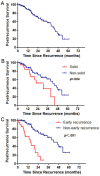Solid predominant histologic subtype and early recurrence predict poor postrecurrence survival in patients with stage I lung adenocarcinoma
- PMID: 27732964
- PMCID: PMC5351690
- DOI: 10.18632/oncotarget.12540
Solid predominant histologic subtype and early recurrence predict poor postrecurrence survival in patients with stage I lung adenocarcinoma
Abstract
Introduction: This study investigated the correlation between histologic predominant pattern and postrecurrence survival (PRS), and identified the clinicopathologic factors influencing PRS in patients with completely resected stage I lung adenocarcinoma.
Methods: A total of 136 stage I lung adenocarcinoma patients who experienced tumor recurrence after completely resection were included in this study. To analysis the association between histologic predominant pattern and PRS, invasive adenocarcinomas with mixed histologic components were divided into 2 groups: solid and nonsolid group (including lepidic, acinar, papillary, micropapillary) based on the histologic predominant pattern. PRS was analyzed to identify the prognostic predictors using the Kaplan-Meier approach and multivariable Cox models.
Results: For all stage I invasive adenocarcinoma patients, the majority of postsurgical recurrences occurred within 2 years. Patients with solid predominant histological pattern were associated with unfavorable PRS (HR, 2.40; 95%CI 1.13-5.08, p=.022). There was a significant difference for poor PRS for patients who diagnosed tumor recurrence shorter than 12 months after surgery (HR, 2.34; 95%CI 1.12-4.90, p=.024). Extrathoracic metastasis was associated with poor media PRS in univariable analysis (p =.011), however, there was no significant PRS difference in multivariable analysis (HR, 1.56; 95%CI 0.65-3.73, p=.322) compared with intrathoracic metastasis.
Conclusions: Solid predominant histologic subtype and recurrence free interval less than 12 months predict worse PRS in patients with stage I lung adenocarcinoma.
Keywords: invasive lung adenocarcinoma; non-small cell lung cancer; postrecurrence survival; solid; stage I.
Conflict of interest statement
The authors declare no conflicts of interest.
Figures
References
-
- Tsao MS, Marguet S, Le Teuff G, Lantuejoul S, Shepherd FA, Seymour L, Kratzke R, Graziano SL, Popper HH, Rosell R, Douillard JY, Le-Chevalier T, Pignon JP, Soria JC, Brambilla EM. Subtype Classification of Lung Adenocarcinoma Predicts Benefit From Adjuvant Chemotherapy in Patients Undergoing Complete Resection. Journal of clinical oncology. 2015;33(30):3439–3446. - PMC - PubMed
-
- Zhu CQ, Ding K, Strumpf D, Weir BA, Meyerson M, Pennell N, Thomas RK, Naoki K, Ladd-Acosta C, Liu N, Pintilie M, Der S Seymour L, Jurisica I, Shepherd FA, Tsao MS. Prognostic and predictive gene signature for adjuvant chemotherapy in resected non-small-cell lung cancer. Journal of clinical oncology. 2010;28(29):4417–4424. - PMC - PubMed
-
- Hung JJ, Hsu WH, Hsieh CC, Huang BS, Huang MH, Liu JS, Wu YC. Post-recurrence survival in completely resected stage I non-small cell lung cancer with local recurrence. Thorax. 2009;64(3):192–196. - PubMed
-
- Hung JJ, Jeng WJ, Hsu WH, Wu KJ, Chou TY, Hsieh CC, Huang MH, Liu JS, Wu YC. Prognostic factors of postrecurrence survival in completely resected stage I non-small cell lung cancer with distant metastasis. Thorax. 2010;65(3):241–245. - PubMed
MeSH terms
LinkOut - more resources
Full Text Sources
Other Literature Sources
Medical


